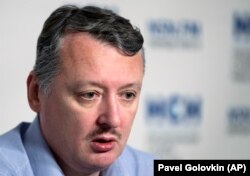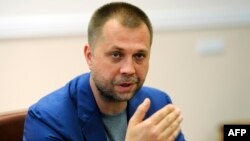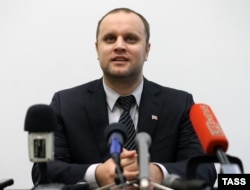In 2014, Russia-backed separatists made their grab for power in Ukraine’s Crimea Peninsula as well as the Donetsk and Luhansk regions, sparking a conflict in the southeast of the country that has left some 13,000 dead, 30,000 wounded, and more than 1 million displaced.
In those early days and years, these were some of the figures wielding influence on the Russia-backed side. What has been their fate five years later?
Igor Girkin, aka Strelkov
With his neatly clipped mustache and coiffed hair, the Russia-born Igor Girkin perhaps didn’t exactly fit the bill of a “monster and killer,” as Ukrainian Interior Minister Arsen Avakov once described him. But with his ultranationalist and alleged Russian security-services ties, Girkin -- or Strelkov (shooter in Russian) -- left a bloody trail in eastern Ukraine, after taking part in wars in Transdniester, Chechnya, and Bosnia-Herzegovina.
The first military chief of the Donetsk-based separatists was linked to allegations of kidnapping, torture, and murder. In 2016, he admitted to executing four people in Slovyansk. Girkin boasted that he was the one who single-handedly fanned the flames in eastern Ukraine, hoping to create “Novorossia,” stretching across much of Ukraine, and, ultimately, Belarus.
In a recent interview, Girkin, now a Kremlin critic, doused Moscow’s claims of a pro-democracy uprising in Crimea, saying deputies had been forced to vote in the “referendum” to join Russia.
A monarchist, Girkin founded the Russian National Movement in 2016, but otherwise has largely fallen off the media radar. He was recently spotted riding the Moscow subway alone.
Arseny Pavlov, aka Motorola
The Russian commander of the infamous Sparta Battalion, Motorola once claimed to have personally executed 15 Ukrainian prisoners of war, a claim he later retracted in an interview with Current Time, the Russian-language network led by RFE/RL in cooperation with VOA.
Rumor has it that Motorola, who toiled at one point as a car-wash attendant, was sent to Donetsk after being arrested for joyriding in Rostov, western Russia, although that claim has never been proven.
In 2014, Pavlov traveled to the eastern Ukrainian city of Slovyansk to fight in an anti-Kyiv force led by Girkin. He later went on to fight in fierce battles against Ukrainian forces in Ilovaysk in August 2014 and Debaltseve in February 2015 -- separatist campaigns that Western intelligence and reporters on the ground said were backed by regular Russian forces.
He was killed on October 16, 2016, when a bomb went off in the elevator of his apartment block, allegedly severing his head. The separatists vowed revenge, while the Ukrainians said he got what he deserved.
Aleksandr Borodai
A self-proclaimed political scientist and “conflictologist” with suspected ties to Russia’s Federal Security Service (FSB), Borodai was the first leader of the Donetsk-based separatists.
Before arriving in Donetsk, Borodai worked as an “adviser” to the top Russian official in Crimea, Sergei Askyonov. Back in Russia, he had worked as a consultant for Konstantin Malofeyev, a Moscow-based tycoon who reportedly helped finance the Russia-backed separatists in eastern Ukraine.
He was part of a group of ultranationalist Russians who were linked to the far-right Zavtra newspaper in the 1990s and advocated for the unity of the Slavic peoples and the idea of a Greater Russia. He was buddies with Girkin, whom he reportedly met in Transdniester.
Borodai resigned as the Donetsk leader in August 2014 amid separatist infighting and Kremlin efforts to give the separatists a more “local face.”
A year later, he was living comfortably in Moscow, working to revive his consultancy firm, despite being blacklisted by the EU and facing possible criminal charges over the July 2014 downing of a Malaysian airliner that killed 298 people. He also pops up from time to time on Russia’s rowdy political talk-show circuit.
Natalia Poklonskaya
A low-level prosecutor in Kyiv, Poklonskaya dramatically rose up the ranks to become the top prosecutor in Russian-annexed Crimea. She headed to Crimea in 2014 shortly after former President Viktor Yanukovych was deposed in the pro-Western protests known as the Maidan. Poklonskaya slammed the Maidan and described the change of government in Kyiv as an “anti-constitutional coup.”
Juxtaposed next to many of the thuggish separatists, Poklonskaya offered a “softer” look. One of her first press conferences in Crimea went viral in Japan, where they turned out manga images and anime fan art inspired by her.
Her photogenic power, however, didn’t stop the EU from blacklisting her.
In 2016, Poklonskaya, then 36, left her prosecutor job after winning a seat in the Russian State Duma for the ruling United Russia party. Some tabloids even picked her to succeed President Vladimir Putin. She became a darling of Russia’s conservative nationalists and led calls to ban Matilda, a film that tells the story of Tsar Nicholas II’s premarital affair with ballerina Matilda Kschessinska.
In July 2018, she was the only United Russia member to vote against unpopular legislation to raise the retirement age as Putin has pushed.
Since then, her star has seemingly dimmed within United Russia.
Pavel Gubarev
The then-31-year-old Gubarev was declared Donetsk’s “people’s governor” by his separatist supporters in March 2014, before they stormed and occupied the regional administration building in Donetsk.
Arrested in March by the Ukrainian Security Service (SBU), Gubarev was swapped by Moscow in May for captured SBU agents.
Before dabbling in separatist politics, Gubarev worked as an advertising agent and moonlighted as a Grandfather Frost entertainer, the Soviet equivalent of a Santa-for-hire.
In 2016, with his rebel luster fading, Gubarev was appointed mayor of a town in separatist-controlled Donetsk, but he was blocked from taking up the post amid infighting.
Down but not deterred, Gubarev made a bid to rule the separatist-run parts of Donetsk in 2018 after former leader Aleksandr Zakharchenko was killed in a cafe explosion. However, his bid to run in the election hit a dead end when the signatures he collected to support his bid were rejected as invalid.
Valery Bolotov
Like Gubarev, Bolotov was another self-styled “people’s governor” in the separatist-controlled parts of the Luhansk region. Bolotov served in the Soviet Army in the late 1980s and was deployed to Azerbaijan's Nagorno-Karabakh region in 1989-90 when fighting broke out between ethnic Armenians and Azerbaijanis.
Days after separatists held an unrecognized independence referendum on May 11, 2014, Bolotov reportedly survived an apparent assassination attempt. However, by January 2017 his luck appears to have run out. Weeks after falling ill in Moscow, Bolotov died.
Initial reports said Bolotov suffered a heart attack, but his wife told Russian media that she suspected poisoning. Yelena Bolotov said her husband felt unwell after returning from a “business meeting” with two men at a cafe in an ice hockey complex in Moscow.
“All evening, he kept saying, ‘Why did I drink that coffee?’” she recalled.















